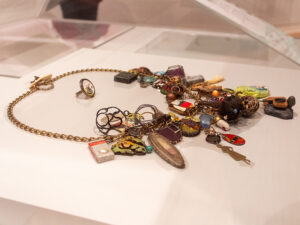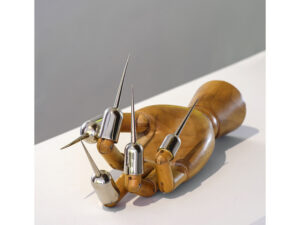Gallery S O houses its temporary exhibitions in a small hall behind its permanent salesroom in what used to be a string factory. As the gallery assistant unlocked the room for me during my visit, I noticed ‘Hans Stofer’ written in gold on the architrave above the door, as if we were entering a prestigious family mausoleum.
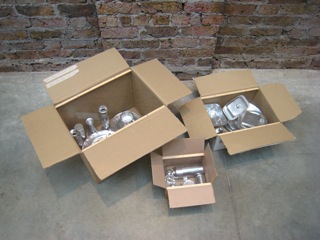
Missing from this list is the dichotomy between tools and sculpture. This is important because this exhibition is not just an entrance point to Stofer’s creative headspace, but a focused interrogation of the concept of tools and tooling.
Tooling has aroused recent attention within applied art theory. Craft theorist Glenn Adamson wrote a short essay called ‘Tooling Up and Tooling Down’ in Eighteen Proposals, a catalogue for Royal College of Art ceramics and glass graduating students (May 2010) in which he positioned ‘vertical movement within the single meta-field of tooling’ as a potential post-disciplinary strategy. This represents an alternative approach to the current popularity of lateral movement across disciplines (for example, a jeweler engaging with sculpture) and might involve deliberately using the wrong tool for the job, or conflating different tools together. An example of this ‘tool-as-art’ genre is Tim Hawkinson’s Signature (1993) that combines an old school chair with winged platform, a ballpoint pen, a roll of cash register tape and motorized elements to make a contraption that endlessly reproduces his own signature. The chits of paper pile up, making an obvious statement about artistic authorship, but the work also provokes an enquiry into the relationship between art object and tool.
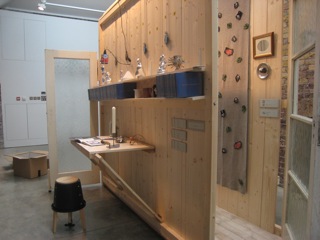
Stofer’s exhibition Walk the Line does not indulge in such an infatuation with tools. Instead there is a playful provocation of the tool as sculpture. Paintbrushes with spoon ends are standing in jam jars and stained tin cans; a jug is made from a one-pint plastic milk vessel and an orange juice carton; nails have tiny ornamental heads on them that would make them frustrating to use in any DIY project; buckets become chairs; a trowel has a candle for a handle. Tools are twisted, made ridiculous and denied of function; conversely, found objects are made into tools.
Many of Sofer’s works fall into the Duchampian tradition of the assisted readymade, taking a found object and doing something extra to it. The Swiss Gruyère cheese is not asking to be judged as an art object by itself but is shaped into a cross, parodying traditional jewelry iconography. At the end of the corridor is Off My Trolley, a wooden cart laden with what appears to be shards of the artistic process – cigarettes, graffiti, smears, half-used paint tubes and plastic cups. But each piece is constructed by hand: what appears to be a stubbed cigarette, for example, is actually made of metal.
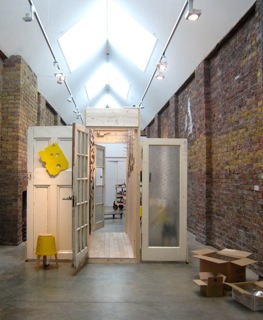
The title of the show recalls the famous Johnny Cash song ‘I Walk the Line.’ Of course we could explain this choice of title as a reference to treading the fine line between all those dichotomies mentioned earlier – the treacherous path of the maker between art and craft. But there is an alternative reading. Cash often recalled that when composing this song in the 1950s that he wanted to use a snare drum. However, this instrument was unpopular in country music at the time, so instead he put a piece of paper between the guitar strings and the fretboard to create his own ‘snare-drum’ effect. It is perhaps this more obscure reference, the making of a tool specific to need, that we should look to for in a more provocative reading of the show.

